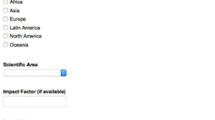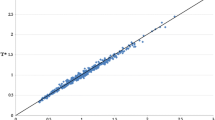Abstract
Measurement of research activity still remains a controversial question. The use of the impact factor from the Institute for Scientific Information (ISI) is quite widespread nowadays to carry out evaluations of all kinds; however, the calculation formula employed by ISI in order to construct its impact factors biases the results in favour of knowledge fields which are better represented in the sample, cite more in average and whose citations are concentrated in the early years of the articles.
In the present work, we put forward a theoretical proposal regarding how aggregated normalization should be carried out with these biases, which allows comparing scientific production between fields, institutions and/or authors in a neutral manner. The technical complexity of such work, together with data limitations, lead us to propose some adjustments on the impact factor proposed by ISI which — although they do not completely solve the problem — reduce it and allow glimpsing the path towards more neutral evaluations. The proposal is empirically applied to three analysis levels: single journals, knowledge fields and the set of journals from the Journal Citation Report.
Similar content being viewed by others
References
Adam, D. (2002), The counting house. Nature, 415: 725–729.
Aksnes, D. W. (2006), Citation rates and perceptions of scientific contribution. Journal of the American Society for Information Science and Technology, 57(2): 169–185.
Archambault, E., Vignola-Gagne, E., Côte, G., Larivière, V., Gingras, Y. (2006), Benchmarking scientific output in the social sciences and humanities — The limits of existing databases. Scientometrics, 68(3): 329–342.
Bar-Ilan, J. (2008), Informetrics at the beginning of the 21st century — A review. Journal of Informetrics, 2: 1–52.
Bollen, J., Rodriguez, M. A., van De Sompel, H. (2006), Journal status, Scientometrics, 69(3): 669–687.
Bordons, M., Barrigón, S. (1992), Bibliometric analysis of publications of Spanish pharmacologists in the SCI (1984–89). Part II. Contribution to subfields other than “Pharmacology & Pharmacy (lSI)”. Scientometrics, 25(3): 425–446.
Brookes, B. C. (1970), The growth, utility, and obsolescence of scientific periodical literature. Journal of Documentation, 26: 458–461.
Buchanan, R. A. (2006), Accuracy of cited references — The role of citation databases. College & Research Libraries, 67(4): 292–303.
Butler, L., Visser, M. S. (2006), Extending citation analysis to non-source items. Scientometrics, 66(2): 327–343.
Egghe, L., Rousseau, R. (1990), Introduction to Infometrics. Quantitative Methods in Library, Documentation and Information Science. Elsevier, Amsterdam.
Garfield, E. (1996), How can impact factors be improved? British Medical Journal, 313: 411–413.
Garfield, E. (1998), Long-term vs. short-term journal impact: part ii. cumulative impact factors. The Scientist, 12(14): 12–13.
Garfield, E. (1999), Journal impact factor: A brief review. Canadian Medical Association 161(8): 979–980.
Glänzel, W., Moed, H. F. (2002), Journal impact measures in bibliometric research. Scientometrics, 53(20): 171–193.
Gómez Sancho, J. M. (2005), La evaluación de la eficiencia productiva de las Universidades Públicas Españolas, tesis doctoral, Universidad de Zaragoza, Spain
Jacsó, P. (2006), Deflated, inflated and phantom citation counts. Online Information Review, 30(3): 297–309.
Kostoff, R. N. (2002), Citation analysis of research performer quality. Scientometrics, 53(1): 49–71.
Leydesdorff, L. (2008), Caveats for the use of citation indicators in research and journal evaluations. Journal of the American Society for Information Science and Technology, 59(2): 278–287.
Marshakova-Shaikevich, I. (1996), The standard impact factor as an evaluation tool of science fields and scientific journals, Scientometrics, 35(2): 283–290.
Moed, H. F. (2002), The impact-factors debate — The ISI’s uses and limits. Nature, 415: 731–732.
Moed, H. F., Van Leeuwen, T. N. (1995), Improving the accuracy of institute for scientific information’s journal impact factors. Journal of the American Society for Information Science and Technology, 46(6): 461–467.
Moed, H. F., Van Leeuwen, T. N., Reedijk, J. (1998), A new classification system to describe the ageing of scientific journals and their impact factors. Journal of Documentation, 54(4): 387–419.
Moed, H. F., van Leeuwen, T. N., Reedijk, J. (1999), Towards appropiate indicators of journal impact. Scientometrics, 46(3): 575–589.
Moed, H. F., Vriens, M. (1989), Possible inaccuracies occurring in citation analysis. Journal of Information Science, 15: 95–107
Mueller, P. S., Murali, N. S., Cha, S. S., Erwin, P. J. Y Ghosh, A. K. (2006), The association between impact factors and language of general internal medicine journals. Swiss Medical Weekly, 136(27/28): 441–443.
Pinski, G., Narin, F. (1976), Citation influence for journal aggregates of scientific publications: Theory, with application to the literature of physics, Information Processing & Management, 12(5): 297–312.
Pudovkin A. I., Garfield E. (2004), Rank-normalized impact factor: a way to compare journal performance across subject categories. In: Proceedings of the 67th Annual Meeting of the American Society for Information Science & Technology. Vol 41. Silver Spring, Md: American Society for Information Science & Technology, pp. 507–515
Reedijk, J., Moed, H. F. (2008), Is the impact of journal impact factors decreasing? Journal of Documentation, 64(2): 183–192.
Rinia, E. J., van Leeuwen, T. N., Bruins, E. E. W., van Vuren, H. G., van Raan, A. F. J. (2001), Citation delay in interdisciplinary knowledge exchange. Scientometrics, 51(1): 293–309.
Rousseau, R. (2005), Median and percentile impact factors: A set of new indicators. Scientometrics, 63(3): 431–441.
Schubert, A., Braun, T. (1993), Reference standards for citation based assessments. Scientometrics, 26(1): 21–35.
Schubert, A., Braun, T. (1996), Cross-field normalization of scientometric indicators. Scientometrics, 36(1): 311–324.
Seglen, P. O. (1997a), Why the impact factor of journals should not be used for evaluating research. British Medical Journal, 314(7079): 498–502.
Seglen, P. O. (1997b), Citations and journal impact factors: Questionable indicators of research quality. Allergy, 52(11): 1050–1056.
Sen B.K. (1992), Documentation note normalized impact factor. Journal of Documentation, 48(3): 318–325.
Sombatsompop, N., Markpin, T., Premkamolnetr, N. (2004), A modified method for calculating the impact factors of journals in ISI Journal Citation Reports — Polymer science category in 1997–2001. Scientometrics, 60(2): 235–271.
van Leeuwen, T. N., Moed, H. F., Tijssen, R. J. W., Visser, M. S., van Raan, A. F. J. (2001), Language biases in the coverage of the Science Citation Index and its consequences for international comparisons of national research performance. Scientometrics, 51(1): 335–346.
Vinkler, P. (2002), Subfield problems in applying the Garfield (Impact) Factors in practice. Scientometrics, 53(2): 267–279.
Wallin, J. A. (2005), Bibliometric methods: Pitfalls and possibilities. Basic & Clinical Pharmacology & Toxicology, 97(5): 261–275.
Whitehouse, G. H. (2002), Impact factors: facts and myths. European Radiology, 12(4): 715–717.
Wilson, C. S. (1999), Informetrics. In: M. E. Williams (Eds), Annual Review of Information Science and Technology. Medford, NJ: Information Today, pp. 107–247.
Zitt, M., Ramana-rahary, S., Bassecoulard, E. (2005), Relativity of citation performance and excellence measures: From cross-field to cross-scale effects of field-normalisation, Scientometrics, 63 (2).
Zitt, M., Small, H. (2008), Modifying the journal impact factor by fractional citation weighting: The audience factor, Journal of the American Society for Information Science and Technology, 59(11): 1856–1860.
Author information
Authors and Affiliations
Corresponding author
Rights and permissions
About this article
Cite this article
Gómez-Sancho, J.M., Mancebón-Torrubia, M.J. The evaluation of scientific production: Towards a neutral impact factor. Scientometrics 81, 435–458 (2009). https://doi.org/10.1007/s11192-008-2137-1
Received:
Published:
Issue Date:
DOI: https://doi.org/10.1007/s11192-008-2137-1




